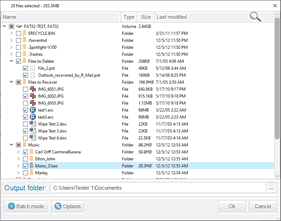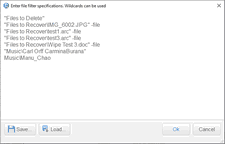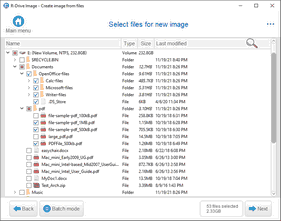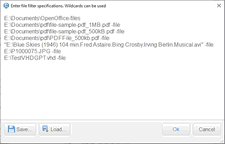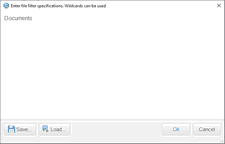

- Contents
- Index
- R-Drive Image
- Disk Actions
- Advanced File Filtering
- RAIDs, and Various Disk and Volume Managers
- Startup Version
- Scheduled Actions, Command Line Operations, and Scripting
-
Technical Information
- Updates
- Cloud Services
- FTP/FTPS Servers
- Network Drives
- Image Replications
- Logging
- Creating Consistent Point-in-Time Backups
- Support for Various Disk Partitioning Schemes and File Systems
- Supported Virtual Disk and Disk Image Formats
- Disk Wiping Algorithms
- Supported CD and DVD Recorders
- List of Hardware Devices Supported in the Startup Mode
- R-Drive Image OEM kit
© 2025 R-Tools Technology Inc.
All rights reserved.
Batch Mode
Batch mode is a way to apply very complex sets of file filters for automated search for folders and files and marking them for backup or restore. Such sets can be saved for future use and loaded when necessary.
The simple way to specify such a set is to mark all necessary files and folders manually on the Select Files to Restore panel and click the Batch mode button. Depending whether files or folders are on a disk or in a image, their paths may look slightly different.
Sets are stored in the plain text format (the rdf file extension), and can be composed or edited in the Batch window or in any text editor capable of exporting text in this format. Below are the rules that should be followed while writing filter sets.
Every filter set consists of strings each representing a single filter. They are executed in the top to bottom order. If, for example, files are to be marked according to the first string, but unmarked according to the seventh string, they will eventually be unmarked.
Filters can include file names, file paths, and wildcards, like * and ?. They can also have some keys that modify their impact on the search results. If a path in the filter has a space in it, it should be enclosed in quotation marks.
Switches that modify file filters:
|
-no |
This filter unmarks the folders or files it's applied to. I.g., C:\Photos\*.jpg -no unmarks all jpg files in the C:\Photos folder. |
|
-file |
This filter is applied to files. May be shorten to -fi . -no-file negates the filter, making it applied not to files. |
|
-dir |
This filter is applied to folders. May be shorten to -d . -no-dir negates the filter, making it applied not to folders.. |
|
-case |
This filter is case-sensitive. May be shorten to -c . -no-case makes the filter case-insensitive. |
|
-local |
This filter is applied to the current folder, not to its subfolders. May be shorten to -l . -no-local negates the filter making it applied to the folder and its subfolders. |
|
-recursive |
This filter is applied to the current folder and its subfolders. May be shorten to -r . -no-recursive negates the filter making it applied only to the folder. |
|
-from: |
The initial date from which files will be marked. It may be either in the form of exact date: -from:20210101 , or relative to the current date: -from:now-3week . Has no effect on folders. May be shorten to -fr. |
|
-to: |
The final date to which files will be marked. It may be either in the form of exact date: -to:20211201 , or relative to the current date: -to:now-1week . Has no effect on folders. |
An exact date may be specified as a local time YearMonthDayHour24MinSec , or as a UTC time YearMonthDayHour24MinSecU .
Provided that there's no switches in the filter (i.g., -recursive ), a file path in the file filter ending with a path separator is applied to the files in the folder and its subfolders. If not, only to the files in the folder.
The file filter D:\Files\ will be applied to the files in the D:\Files\ .
The file filter D:\Files will be applied to the files in the D:\Files and in its subfolders.
Below is an example of filters recursively applied to files in the D:\Files\Pictures folder and its subfolders.
D:\Files\Pictures
D:\Files\Pictures\My_Photo -no
D:\Files\Pictures\My_Photo\Home??????.jpg
Line 1: All files will be marked in the D:\Files\Pictures folder and its subfolders will be marked.
Line 2. All files in the D:\Files\Pictures\My_Photo folder will be unmarked.
Line 3: Files named like Home210312.jpg in the folder D:\Files\Pictures\My_Photo\ will be marked.
An importance notice about marking a folder.
If you mark all files in the folder but not the folder itself, its mark will be the following:
The batch will look like:
And the folder will be restored only if there are marked files/folders in it.
If you mark the folder, its mark will be the following:
The batch will look like:
And the folder will always be restored regardless whether there are marked files/folders in it.
- R-Studio Technician: activation using a USB stick
- Data Recovery Guide
- Why R-Studio?
- R-Studio for Forensic and Data Recovery Business
- R-STUDIO Review on TopTenReviews
- File Recovery Specifics for SSD devices
- How to recover data from NVMe devices
- Predicting Success of Common Data Recovery Cases
- Recovery of Overwritten Data
- Emergency File Recovery Using R-Studio Emergency
- RAID Recovery Presentation
- R-Studio: Data recovery from a non-functional computer
- File Recovery from a Computer that Won't Boot
- Clone Disks Before File Recovery
- HD Video Recovery from SD cards
- File Recovery from an Unbootable Mac Computer
- The best way to recover files from a Mac system disk
- Data Recovery from an Encrypted Linux Disk after a System Crash
- Data Recovery from Apple Disk Images (.DMG files)
- File Recovery after Re-installing Windows
- R-Studio: Data Recovery over Network
- How To Use R-Studio Corporate Package
- Data Recovery from a Re-Formatted NTFS Disk
- Data Recovery from an ReFS disk
- Data Recovery from a Re-Formatted exFAT/FAT Disk
- Data Recovery from an Erased HFS Disk
- Data Recovery from an Erased APFS Disk
- Data Recovery from a Re-Formatted Ext2/3/4FS Disk
- Data Recovery from an XFS Disk
- Data Recovery from a Simple NAS
- How to connect virtual RAID and LVM/LDM volumes to the operating system
- Specifics of File Recovery After a Quick Format
- Data Recovery After Partition Manager Crash
- File Recovery vs. File Repair
- Data Recovery from Virtual Machines
- How to Recover Files from a Remote Computer Using R-Studio Standalone License and Its Network Capabilities in Demo Mode
- How to Connect Disks to a Computer
- Emergency Data Recovery over Network
- Data Recovery over the Internet
- Creating a Custom Known File Type for R-Studio
- Finding RAID parameters
- Recovering Partitions on a Damaged Disk
- NAT and Firewall Traversal for Remote Data Recovery
- Data Recovery from an External Disk with a Damaged File System
- File Recovery Basics
- Default Parameters of Software Stripe Sets (RAID 0) in Mac OS X
- Data Recovery from Virtual Hard Disk (VHD/VHDX) Files
- Data Recovery from Various File Container Formats and Encrypted Disks
- Automatic RAID Parameter Detection
- IntelligentScan Data Recovery Technology
- Multi-pass imaging in R-Studio
- Runtime Imaging in R-Studio
- Linear Imaging vs Runtime Imaging vs Multi-Pass Imaging
- USB Stabilizer Tech for unstable USB devices
- Joint work of R-Studio and PC-3000 UDMA hardware
- Joint work of R-Studio and HDDSuperClone
- R-Studio T80+ - A Professional Data Recovery and Forensic Solution for Small Business and Individuals Just for 1 USD/day
- Backup Articles
- R-Drive Image Standalone and Corporate license transferring
- Fixing Windows update error 0x80070643 with R-Drive Image
- Backup with Confidence
- R-Drive Image as a free powerful partition manager
- Computer Recovery and System Restore
- Disk Cloning and Mass System Deployment
- Accessing Individual Files or Folders on a Backed Up Disk Image
- R-Drive Image startup / bootable version
- File Backup for Personal Computers and Laptops of Home and Self-Employed Users
- Creating a Data Consistent, Space Efficient Data Backup Plan for a Small Business Server
- How to Move the Already Installed Windows from an Old HDD to a New SSD Device and Create a Hybrid Data Storage System
- How to Move an Installed Windows to a Larger Disk
- How to Move a BitLocker-Encrypted System Disk to a New Storage Device
- How to backup and restore disks on Linux and Mac computers using R-Drive Image
- Undelete Articles
- Get Deleted Files Back
- Free Recovery from SD and Memory cards
- R-Undelete: Video Recovery
- Recovery from an External Device with a Damaged File System
- File recovery from a non-functional computer
- Free File Recovery from an Android Phone Memory Card
- Free Photo and Video File Recovery Tutorial
- Easy file recovery in three steps


